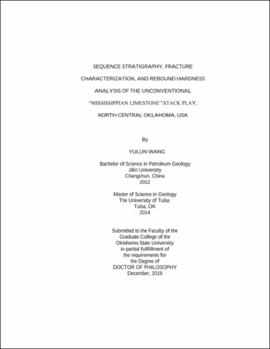| dc.contributor.advisor | Grammer, G. Michael | |
| dc.contributor.author | Wang, Yulun | |
| dc.date.accessioned | 2020-06-26T21:27:57Z | |
| dc.date.available | 2020-06-26T21:27:57Z | |
| dc.date.issued | 2019-12 | |
| dc.identifier.uri | https://hdl.handle.net/11244/324882 | |
| dc.description.abstract | The "Mississippian Limestone"/STACK play in Oklahoma has been a prolific hydrocarbon play for decades. However, several critical aspects, all of which are valuable for reservoir characterization, such as core-based sequence stratigraphy and fracture distribution, and rebound hardness (RHN), are not well understood. To address these topics with an integrated approach, this study utilizes six cores from four counties in north-central Oklahoma and a time-equivalent outcrop in northwestern Arkansas, the latter of which is evaluated for a fracture analog. | |
| dc.description.abstract | In all cores combined, seven mudstone, siltstone, and silty limestone facies are present that exhibit vertical cyclicity at various scales, defining a hierarchical sequence stratigraphic framework. (Sub)vertical, naturally mineralized fractures are common in all cores, with the highest average fracture intensity corresponding to the silty limestone-rich intervals (i.e., regressive phases of "third-order" sequences), which commonly show distinctively low gamma-ray values. These observations imply the potential value of sequence stratigraphy in characterizing and predicting fracture distribution in these unconventional reservoirs. In the outcrop, which is composed of carbonate mudstone and chert, similar types of fractures are present, with overall higher fracture intensity in chert. The distribution pattern of attribute data (height, kinematic aperture, spacing) is affected by lithology, fracture type, and fracture height, pointing to a cooperative role of lithology, fracture type, and fracture-bedding relationships in affecting fracture attributes. Because of different dominant lithologies, this outcrop does not work as a direct fracture analog for the play areas of this study. For RHN analysis, plug samples from the Vaca Muerta Formation provide supplemental data. 2D crossplots between the collected RHN data and the rock data (mineralogy, porosity, sonic velocity, elastic parameters) show correlative trends with clustering by facies groups, implying the effect of facies in the statistical pattern and the value of RHN for rock typing. Variable correlation coefficient suggests variable capabilities of RHN in predicting rock properties, which can be related to the multivariate control of RHN as suggested by leverage analysis. In addition, regression analysis indicates that RHN can potentially assist in the prediction of certain rock properties. These observations imply the potential value of RHN in reservoir characterization. | |
| dc.format | application/pdf | |
| dc.language | en_US | |
| dc.rights | Copyright is held by the author who has granted the Oklahoma State University Library the non-exclusive right to share this material in its institutional repository. Contact Digital Library Services at lib-dls@okstate.edu or 405-744-9161 for the permission policy on the use, reproduction or distribution of this material. | |
| dc.title | Sequence stratigraphy, fracture characterization, and rebound hardness analysis of the unconventional "Mississippian Limestone"/STACK play, north-central Oklahoma, USA | |
| dc.contributor.committeeMember | Pashin, Jack | |
| dc.contributor.committeeMember | Lao Davila, Daniel A. | |
| dc.contributor.committeeMember | Eberli, Gregor | |
| dc.contributor.committeeMember | Nygaard, Runar | |
| osu.filename | Wang_okstate_0664D_16537.pdf | |
| osu.accesstype | Open Access | |
| dc.type.genre | Dissertation | |
| dc.type.material | Text | |
| dc.subject.keywords | "miss lime"/stack play | |
| dc.subject.keywords | fracture analysis | |
| dc.subject.keywords | rebound hardness | |
| dc.subject.keywords | sequence stratigraphy | |
| thesis.degree.discipline | Geology | |
| thesis.degree.grantor | Oklahoma State University | |
